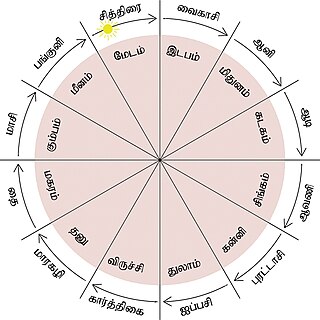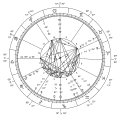
Wuxing, usually translated as Five Phases or Five Agents, is a fivefold conceptual scheme used in many traditional Chinese fields of study to explain a wide array of phenomena, including cosmic cycles, the interactions between internal organs, the succession of political regimes, and the properties of herbal medicines.

The Pig or sometimes translated as the Boar is the twelfth of the 12-year cycle of animals which appear in Chinese zodiac, in relation to the Chinese calendar and system of horology, and paralleling the system of ten Heavenly Stems and twelve Earthly Branches. Although the term "zodiac" is used in the phrase "Chinese zodiac", there is a major difference between the Chinese usage and Western astrology: the zodiacal animals do not relate to the zodiac as the area of the sky that extends approximately 8° north or south of the ecliptic, the apparent path of the Sun, the Moon, and visible planets across the celestial sphere's constellations, over the course of the year.

The rabbit is the fourth in the twelve-year periodic sequence (cycle) of animals that appear in the Chinese zodiac related to the Chinese calendar. The Year of the Rabbit is associated with the Earthly Branch symbol 卯. the element Wood in Wuxing theory and within Traditional Chinese medicine the Liver Yin and the emotions and virtues of kindness and hope.

The Ox is the second of the 12-year periodic sequence (cycle) of animals which appear in the Chinese zodiac related to the Chinese calendar, and also appears in related calendar systems. The Chinese term translated here as ox is in Chinese niú , a word generally referring to cows, bulls, or neutered types of the bovine family, such as common cattle or water buffalo. The zodiacal ox may be construed as male, female, neutered, hermaphroditic, and either singular or plural. The Year of the Ox is also denoted by the Earthly Branch symbol chǒu. The term "zodiac" ultimately derives from an Ancient Greek term referring to a "circle of little animals". There are also a yearly month of the ox and a daily hour of the ox. Years of the oxen (cows) are cyclically differentiated by correlation to the Heavenly Stems cycle, resulting in a repeating cycle of five years of the ox/cow, each ox/cow year also being associated with one of the Chinese wǔxíng, also known as the "five elements", or "phases": the "Five Phases" being Fire, Water, Wood, Metal, and Earth. The Year of the Ox follows after the Year of the Rat which happened in 2020 and is then followed by the Year of the Tiger, which happened in 2022.

The Rat or Mouse is the first of the repeating 12-year cycle of animals which appear in the Chinese zodiac, constituting part of the Chinese calendar system. The Year of the Rat in standard Chinese is Chinese: 鼠年; pinyin: shǔnián. The rat is associated with the first branch of the Earthly Branch symbol 子 (zǐ), which starts a repeating cycle of twelve years. The Chinese word shǔ refers to various small rodents (Muroidea), such as rats and mice. The term "zodiac" ultimately derives from an Ancient Greek term referring to a "circle of little animals". There are also a yearly month of the rat and a daily hour of the rat. Years of the rat are cyclically differentiated by correlation to the Heavenly Stems cycle, resulting in a repeating cycle of five years of the rat, each rat year also being associated with one of the Chinese wu xing, also known as the "five elements", or "phases": the "Five Phases" being Fire, Water, Wood, Metal, and Earth.

The twelve Earthly Branches or Terrestrial Branches are a Chinese ordering system used throughout East Asia in various contexts, including its ancient dating system, astrological traditions, zodiac and ordinals.

In Western astrology, astrological signs are the twelve 30-degree sectors that make up Earth's 360-degree orbit around the Sun. The signs enumerate from the first day of spring, known as the First Point of Aries, which is the vernal equinox. The astrological signs are Aries, Taurus, Gemini, Cancer, Leo, Virgo, Libra, Scorpio, Sagittarius, Capricorn, Aquarius, and Pisces. The Western zodiac originated in Babylonian astrology, and was later influenced by the Hellenistic culture. Each sign was named after a constellation the sun annually moved through while crossing the sky. This observation is emphasized in the simplified and popular sun sign astrology. Over the centuries, Western astrology's zodiacal divisions have shifted out of alignment with the constellations they were named after by axial precession of the Earth while Hindu astrology measurements correct for this shifting. Astrology was developed in Chinese and Tibetan cultures as well but these astrologies are not based upon the zodiac but deal with the whole sky.
In Chinese philosophy, wood, sometimes translated as Tree, is the growing of the matter, or the matter's growing stage. Wood is the first phase of Wu Xing when observing or discussing movement or growth. Wood is the lesser yang character of the Five elements, giving birth to Fire. It stands for springtime, the east, the planet Jupiter, the color green, windy weather, and the Azure Dragon in Four Symbols. Blue and cyan-type colors also represent wood.
In Chinese philosophy, metal or gold, the fourth phase of Wu Xing, is the decline of the matter, or the matter's decline stage. In Traditional Chinese Medicine Metal is yin in character, its motion is going inwards and its energy is contracting. It is associated with the west, dusk, autumn or fall, it governs the Yin, Zang organ the Lung and the Yang, Fu organ colon, nose and skin, pungent smell, maturing of age, the planet Venus, the color white, dry weather, and the White Tiger in Four Symbols. The archetypal metals are silver or gold.

Astrology has used the concept of classical elements from antiquity up until the present. In Western astrology and Sidereal astrology four elements are used: Fire, Earth, Air, and Water.

The Tamil calendar is a sidereal solar calendar used by the Tamil people of the Indian subcontinent. It is also used in Puducherry, and by the Tamil population in Sri Lanka, Malaysia, Singapore, and Mauritius.

The Four Symbols are mythological creatures appearing among the Chinese constellations along the ecliptic, and viewed as the guardians of the four cardinal directions. These four creatures are also referred to by a variety of other names, including "Four Guardians", "Four Gods", and "Four Auspicious Beasts". They are the Azure Dragon of the East, the Vermilion Bird of the South, the White Tiger of the West, and the Black Tortoise of the North. Each of the creatures is most closely associated with a cardinal direction and a color, but also additionally represents other aspects, including a season of the year, an emotion, virtue, and one of the Chinese "five elements". Each has been given its own individual traits, origin story and a reason for being. Symbolically, and as part of spiritual and religious belief and meaning, these creatures have been culturally important across countries in the Sinosphere.

Tai Sui is a Chinese name for stars directly opposite the planet Jupiter in its roughly 12-year orbital cycle. Personified as deities, they are important features of Chinese astrology, Feng Shui, Taoism, and to a lesser extent Chinese Buddhism.
Five Chariots is a constellation in Chinese astronomy.
Zi Wei Dou Shu, commonly referred to in English as Purple Star Astrology, is a form of fortune-telling in Chinese culture. The study of destiny is one of the five arts of Chinese metaphysics. Along with the Bazi chart, Zi Wei Dou Shu is one of the most renowned fortune-telling methods used in this study. Much like western astrology, Zi Wei Dou Shu claims to use the position of the cosmos at the time of one's birth to make determinations about personality, career and marriage prospects, and more.
In Chinese philosophy, fire is the second phase of Wu Xing.
In Chinese philosophy, earth or soil is the changing or central point of physical matter or a subject. Earth is the third element in the Wu Xing cycle.
In Chinese philosophy, water is the low point of matter. It is considered matter's dying or hiding stage. Water is the fifth of the five elements of wuxing.

The Chinese zodiac is a traditional classification scheme based on the Chinese calendar that assigns an animal and its reputed attributes to each year in a repeating twelve-year cycle. In traditional Chinese culture, the Chinese zodiac is very important and exists as a reflection of Chinese philosophy and culture. Chinese folkways held that one's personality is related to the attributes of their zodiac animal. Originating from China, the zodiac and its variations remain popular in many East Asian and Southeast Asian countries, such as Japan, South Korea, Vietnam, Singapore, Nepal, Bhutan, Cambodia, and Thailand.

The Wǔfāng Shàngdì, or simply Wǔdì or Wǔshén are, in Chinese canonical texts and common Chinese religion, the fivefold manifestation of the supreme God of Heaven. This theology dates back at least to the Shang dynasty. Described as the "five changeable faces of Heaven", they represent Heaven's cosmic activity which shapes worlds as tán 壇, "altars", imitating its order which is visible in the starry vault, the north celestial pole and its spinning constellations. The Five Deities themselves represent these constellations. In accordance with the Three Powers they have a celestial, a terrestrial and a chthonic form. The Han Chinese identify themselves as the descendants of the Red and Yellow Deities.













